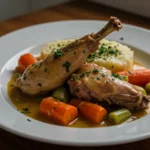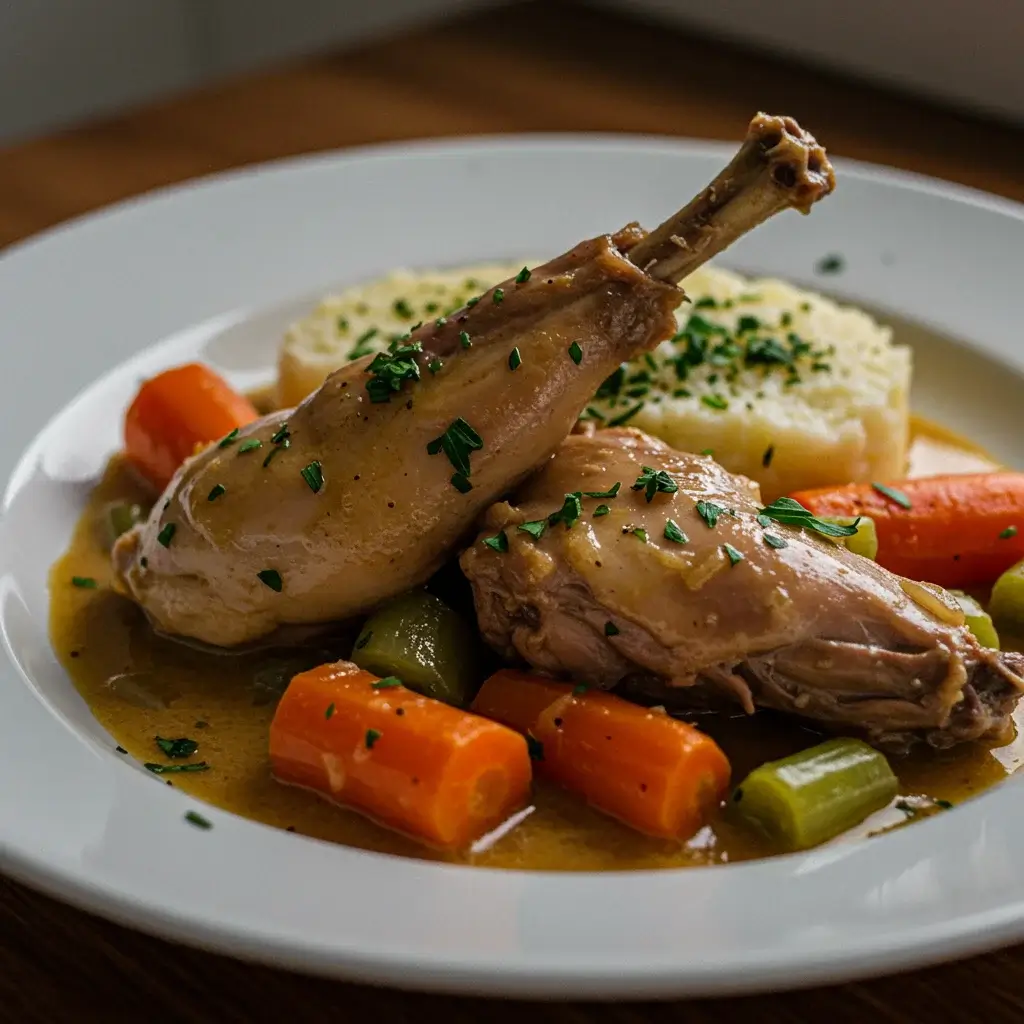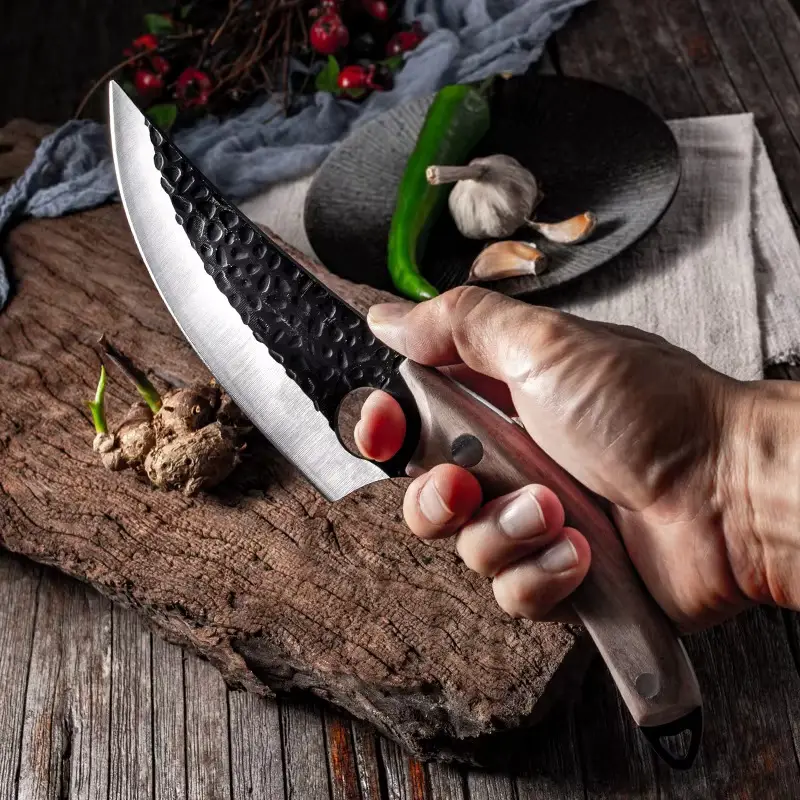Introduction
Braised Rabbit Stew with Vegetables is a delightful dish that captures the essence of rustic cooking. With tender rabbit meat slow-cooked to perfection alongside a medley of fresh vegetables and aromatic herbs, this stew is not only a treat for the taste buds but also a nutrient-rich meal. Whether you’re a seasoned gourmand or new to rabbit as an ingredient, this recipe provides a step-by-step guide to creating a flavorful and satisfying stew that is perfect for any occasion. Dive into this hearty dish that promises comfort and an explosion of flavors in every bite.
Ingredients
To prepare a delicious braised rabbit stew, gather the following ingredients:
- Rabbit: 1 whole rabbit, cut into serving pieces
- Olive Oil: 3 tablespoons
- Salt and Pepper: To taste
- Onion: 1 large, chopped
- Garlic: 4 cloves, minced
- Carrots: 3, sliced
- Celery Stalks: 3, chopped
- Potatoes: 3 medium, diced
- Tomatoes: 2, chopped
- Chicken Broth: 4 cups
- Red Wine: 1 cup
- Bay Leaves: 2
- Thyme: 1 teaspoon, dried
- Rosemary: 1 teaspoon, dried
- Peas: 1 cup, fresh or frozen
- Parsley: Fresh, chopped for garnish
Instructions
Embrace the art of slow cooking with these step-by-step instructions to make your Braised Rabbit Stew with Vegetables:
Preparation
- Prepare the Rabbit: Rinse the rabbit pieces under cold water and pat them dry with paper towels. Season generously with salt and pepper.
- Preheat the Oven: Set your oven to 350°F (175°C) to preheat while you prepare the stew.
Cooking
- Brown the Rabbit: In a large, ovenproof pot or Dutch oven, heat olive oil over medium-high heat. Add the rabbit pieces and brown them on all sides. Once browned, remove the rabbit from the pot and set it aside.
- Sauté the Vegetables: In the same pot, add the chopped onion and garlic. Sauté until they are soft and fragrant. Then, add carrots, celery, and potatoes. Cook for about 5 minutes until they begin to soften.
- Deglaze the Pot: Pour in the red wine to deglaze the pot, scraping up any browned bits from the bottom. Allow the wine to reduce slightly.
- Combine Ingredients: Return the rabbit pieces to the pot. Add tomatoes, chicken broth, bay leaves, thyme, and rosemary. Stir well to combine.
- Simmer: Bring the mixture to a simmer over medium heat.
Baking
- Transfer to Oven: Cover the pot with a lid and transfer it to the preheated oven. Bake for 1.5 to 2 hours until the rabbit is tender and the flavors have melded together.
- Add Peas: About 15 minutes before the stew is done, add the peas to the pot.
Finishing Touches
- Garnish and Serve: Once cooked, remove the stew from the oven. Discard the bay leaves and sprinkle fresh parsley over the top before serving.
Nutrition Facts
Understanding the nutritional content of your meals is essential for maintaining a balanced diet. Here’s a breakdown of the approximate nutrition facts for a serving of Braised Rabbit Stew with Vegetables:
- Calories: 450
- Protein: 38g
- Fat: 20g
- Carbohydrates: 25g
Rabbit meat is a lean protein source, making this stew a health-conscious choice for those looking to enjoy a hearty meal without excessive calories.
How to Serve
Braised Rabbit Stew with Vegetables is not only a hearty and flavorful dish, but it also offers a delightful experience when served thoughtfully. Here are several ways to enhance your dining experience with this exquisite stew:
Bread Pairing
One of the most delightful ways to serve Braised Rabbit Stew is with a side of freshly baked bread. A crusty loaf, such as a rustic sourdough or a warm baguette, is ideal for soaking up the rich, savory broth that characterizes this dish. The contrast of the crusty exterior and soft interior of the bread creates a wonderful texture that complements the stew beautifully.
Serving Tip: Slice the bread into thick pieces and place it in a rustic breadbasket lined with a linen cloth to keep it warm. For an added touch, consider offering a selection of flavored butters, such as garlic herb or sun-dried tomato, to spread on the bread, enhancing its flavor and making each bite even more indulgent.
Side Dishes
To balance the hearty nature of the stew, consider serving it alongside fresh, vibrant side dishes. Steamed greens, such as broccoli, green beans, or Swiss chard, not only add a splash of color to the plate but also contribute essential nutrients and a lightness that contrasts with the richness of the stew.
A simple garden salad can also be an excellent accompaniment. Use a mix of crisp lettuce, cherry tomatoes, cucumbers, and perhaps some thinly sliced red onion, dressed lightly with a vinaigrette made from olive oil, vinegar, salt, and pepper. The acidity from the vinaigrette will cut through the richness of the stew, making each bite feel refreshing.
Presentation Tip: Serve the stew in a wide, shallow bowl to allow for a generous portion of broth and vegetables, and place the side dishes in smaller bowls to create an inviting family-style dining experience.
Wine Pairing
No meal is complete without a carefully chosen beverage to enhance the flavors of the dish, and Braised Rabbit Stew is no exception. A robust red wine, such as a Cabernet Sauvignon or Merlot, pairs beautifully with the rich, savory notes of the stew. The tannins in the wine will soften the flavors of the rabbit and the vegetables, while the wine’s fruitiness can complement the earthiness of the dish.
If you prefer a white wine, consider a full-bodied option such as a Chardonnay, which can be oaked to provide a buttery texture that harmonizes well with the stew. Alternatively, a light-bodied red like Pinot Noir can also work, offering a fruit-forward profile that won’t overpower the delicate flavors of the rabbit.
Serving Tip: Serve the wine in appropriate glassware to enhance the tasting experience. The wine should be slightly chilled (if white) or at room temperature (if red) to maximize its flavors. You could even consider decanting the red wine for about 30 minutes before serving to allow it to breathe, further enriching the tasting experience.
Garnishes and Final Touches
To elevate your stew even further, consider adding a few garnishes just before serving. Chopped fresh herbs, such as parsley or thyme, can add a pop of color and freshness. A sprinkle of lemon zest can introduce a hint of brightness, cutting through the richness of the stew.
Final Presentation Tip: Serve the stew in individual bowls and garnish each with a sprig of fresh herb. This not only enhances the visual appeal but also offers a tantalizing aroma as you bring the bowls to the table.
By thoughtfully considering the pairing of bread, side dishes, and wine, as well as the presentation of Braised Rabbit Stew with Vegetables, you can create a memorable dining experience that delights the senses and invites conversation.
Additional Tips
Creating a delicious Braised Rabbit Stew with Vegetables involves more than just following a recipe; it requires thoughtful selection of ingredients and techniques that will elevate your dish to new heights. Here are some detailed tips to ensure your stew is not only flavorful but also a memorable culinary experience.
Rabbit Selection
Choosing the right rabbit is crucial for achieving the best flavor and texture in your stew. Look for a rabbit that is fresh, ideally sourced from a reputable butcher or a local farmers’ market. Fresh rabbit should have a clean, mild scent and firm, pinkish flesh. Avoid any rabbit that appears discolored or has an off-putting smell. If possible, ask your butcher about the rabbit’s provenance; sustainably raised rabbits often have superior flavor due to their natural diet and humane rearing conditions. Additionally, consider the age of the rabbit; younger rabbits tend to be more tender and flavorful, making them ideal for braising.
Marinade Option
For those looking to enhance the flavor profile of their rabbit stew, marinating the rabbit pieces is an excellent technique. A simple marinade can be made with a robust red wine, such as a Merlot or Cabernet Sauvignon, combined with fresh or dried herbs like thyme, rosemary, and bay leaves. Allow the rabbit to marinate overnight in the refrigerator; this will not only infuse the meat with rich flavors but also help to tenderize it. The acidity in the wine breaks down the proteins, resulting in a more succulent dish. Remember to reserve the marinade for later use in the stew, as it can add depth when deglazing the pot.
Thickening the Stew
If you prefer a heartier, thicker stew, there are several methods to achieve this. One effective way is to create a slurry by mixing a tablespoon of cornstarch with an equal amount of cold water. Stir this mixture into your stew during the last 15 minutes of cooking. Make sure to stir well to prevent any lumps from forming. The cornstarch will quickly thicken the stew, giving it a velvety texture that clings to the rabbit and vegetables. Alternatively, you can also thicken your stew by mashing some of the cooked vegetables, such as potatoes or carrots, and stirring them back into the pot. This method not only thickens the stew but also enriches the flavor and adds a rustic charm to the dish.
Herb Variations
While traditional herbs like thyme and parsley work wonderfully in rabbit stew, don’t hesitate to experiment with other herbs to customize your stew’s flavor profile. Sage, with its earthy and slightly peppery notes, can add a comforting warmth that complements the rabbit beautifully. Tarragon, known for its anise-like flavor, can lend a sophisticated twist to the dish. Consider using a combination of herbs to create complexity; for instance, pairing thyme with sage can provide a well-rounded herbal base. Fresh herbs added at the end of cooking will give the stew a vibrant finish, while dried herbs can be introduced earlier in the cooking process to build depth.
Additional Considerations
- Vegetable Selection: Choose a variety of vegetables that not only add flavor but also texture. Root vegetables like carrots, parsnips, and turnips are excellent choices, as they hold up well during the long cooking process. Adding leafy greens like kale or spinach towards the end of cooking can provide a nutritious boost and a pop of color.
- Cooking Vessel: The type of pot you use can impact the final result. A heavy-bottomed Dutch oven is ideal for braising, as it distributes heat evenly and retains moisture. If you don’t have one, a heavy pot with a tight-fitting lid will suffice. Make sure to brown the rabbit well before adding liquids; this step builds a rich flavor base through the Maillard reaction.
- Serving Suggestions: Consider serving your stew with crusty bread, creamy polenta, or over a bed of fluffy rice to soak up the delicious sauce. A sprinkle of fresh herbs or a drizzle of high-quality olive oil can elevate the presentation and flavor.
By incorporating these tips into your cooking process, you can transform your Braised Rabbit Stew with Vegetables into a dish that is not only satisfying but also a true showcase of culinary skill and creativity. Enjoy the journey of making this comforting meal, and don’t hesitate to make it your own!
FAQs
Is rabbit meat healthy?
Yes, rabbit meat is a lean source of protein, low in fat, and rich in vitamins and minerals, making it a healthy choice for those looking to diversify their protein intake.
Can I use a slow cooker?
Absolutely! You can adapt this recipe for a slow cooker by browning the rabbit and sautéing the vegetables first, then transferring all ingredients to the slow cooker. Cook on low for 6-8 hours or until the rabbit is tender.
What can I substitute for red wine?
If you prefer not to use red wine, you can substitute it with additional chicken broth or grape juice for a non-alcoholic option.
Can I freeze the stew?
Yes, this stew freezes well. Cool completely, then store in airtight containers in the freezer for up to 3 months. Thaw in the refrigerator before reheating.
Conclusion
Braised Rabbit Stew with Vegetables is more than just a meal; it’s an experience that brings the warmth of home cooking to your table. With its tender meat, flavorful broth, and vibrant vegetables, this dish is sure to become a favorite in your culinary repertoire. Whether you’re cooking for family, friends, or a special occasion, this stew offers a hearty and fulfilling dining experience. Enjoy the comforting flavors and the joy of creating a dish that celebrates the art of slow cooking.
Print
Braised Rabbit Stew with Vegetables
Ingredients
To prepare a delicious braised rabbit stew, gather the following ingredients:
- Rabbit: 1 whole rabbit, cut into serving pieces
- Olive Oil: 3 tablespoons
- Salt and Pepper: To taste
- Onion: 1 large, chopped
- Garlic: 4 cloves, minced
- Carrots: 3, sliced
- Celery Stalks: 3, chopped
- Potatoes: 3 medium, diced
- Tomatoes: 2, chopped
- Chicken Broth: 4 cups
- Red Wine: 1 cup
- Bay Leaves: 2
- Thyme: 1 teaspoon, dried
- Rosemary: 1 teaspoon, dried
- Peas: 1 cup, fresh or frozen
- Parsley: Fresh, chopped for garnish
Instructions
Embrace the art of slow cooking with these step-by-step instructions to make your Braised Rabbit Stew with Vegetables:
Preparation
- Prepare the Rabbit: Rinse the rabbit pieces under cold water and pat them dry with paper towels. Season generously with salt and pepper.
- Preheat the Oven: Set your oven to 350°F (175°C) to preheat while you prepare the stew.
Cooking
- Brown the Rabbit: In a large, ovenproof pot or Dutch oven, heat olive oil over medium-high heat. Add the rabbit pieces and brown them on all sides. Once browned, remove the rabbit from the pot and set it aside.
- Sauté the Vegetables: In the same pot, add the chopped onion and garlic. Sauté until they are soft and fragrant. Then, add carrots, celery, and potatoes. Cook for about 5 minutes until they begin to soften.
- Deglaze the Pot: Pour in the red wine to deglaze the pot, scraping up any browned bits from the bottom. Allow the wine to reduce slightly.
- Combine Ingredients: Return the rabbit pieces to the pot. Add tomatoes, chicken broth, bay leaves, thyme, and rosemary. Stir well to combine.
- Simmer: Bring the mixture to a simmer over medium heat.
Baking
- Transfer to Oven: Cover the pot with a lid and transfer it to the preheated oven. Bake for 1.5 to 2 hours until the rabbit is tender and the flavors have melded together.
- Add Peas: About 15 minutes before the stew is done, add the peas to the pot.
Finishing Touches
- Garnish and Serve: Once cooked, remove the stew from the oven. Discard the bay leaves and sprinkle fresh parsley over the top before serving.
Nutrition
- Serving Size: one normal portion
- Calories: 450
- Fat: 20g
- Carbohydrates: 25g
- Protein: 38g






